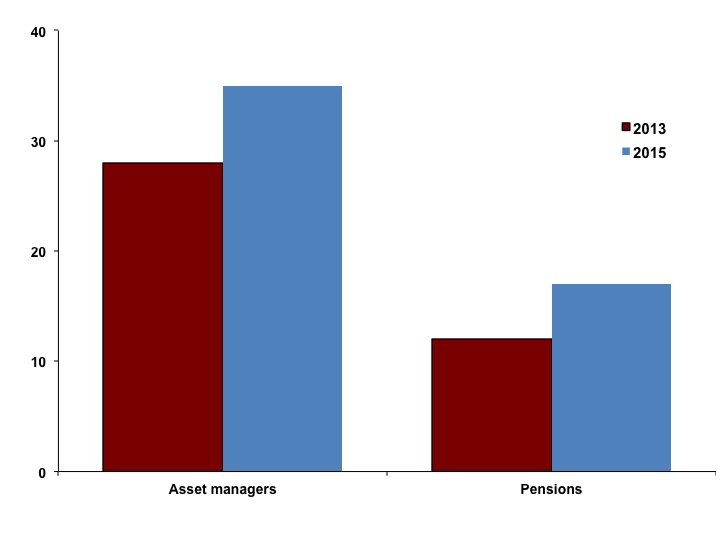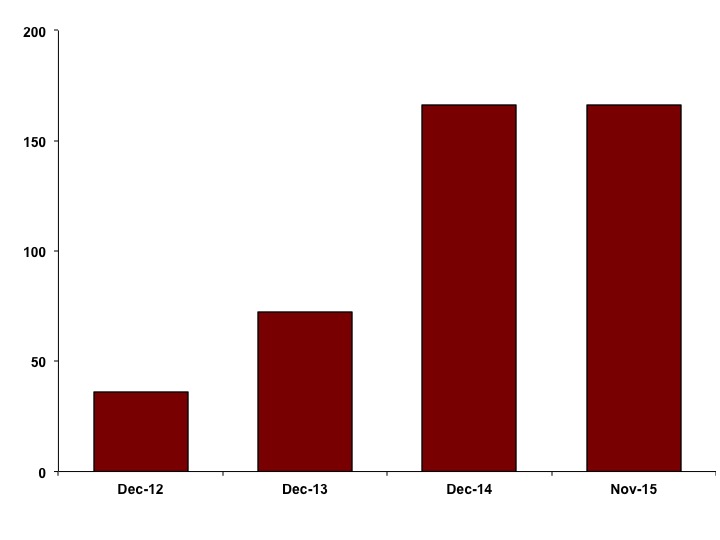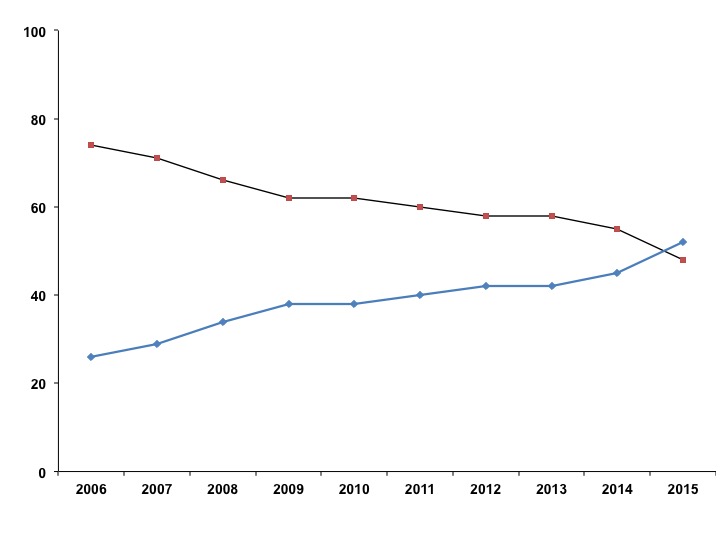The nature of agency lending is changing along with financial markets in the post-Global Financial Crisis era. Agent lenders have become more responsive to their clients, as well as to the needs of their counterparties in the face of complex regulatory requirements. Some institutions view 2016 as an uncertain time for their agency programs, while others have doubled their commitments to the business. At BNP Paribas, we see a great future for our clients and our agency lending program, and we are paying careful attention to the exceptional markets and regulatory context to maintain a successful outcome.
The search for incremental returns has led beneficial owners to entertain a variety of revenue generation strategies which fit within their risk tolerance. Specifically, demand for a customized, separately managed account tailored to a client’s risk profile continues to gain traction. The demand for a flexible program has resulted in greater participation in agency lending services, both custodian-based and third party. In 2013, 28% of large asset managers in the US and Europe engaged a third party agent; in 2015 that figure rose to 35% according to Finadium data (see Exhibit 1). By comparison, only 17% of pension funds engaged third party agents in 2015, which is up from 12% in 2013. We see this reflected in our own program as well; our non-custodial US client base has grown considerably since we launched in 2014.
Exhibit 1:
Asset manager and pension use of third party agent lenders
(Percent)

Source: Finadium
Customization related to liquidity, reinvestment parameters and asset class expertise are often cited as the rationale for engaging in a third party lending strategy. This is a somewhat different model than 20 years ago and has strong commonalities with portfolio management in that clients tend to take an active approach to program management, including the setting of lending limits and asset class participation. The more in demand the asset base, the more that beneficial owners can create specialized programs that maximize the value of their portfolios.
The Market Landscape for Agent Lenders
While clients are weighing the benefits of different models of securities lending, agent lenders themselves are carefully evaluating the changing market landscape to provide the best possible service level for their clients. Agents have a number of major considerations today, including borrower capital costs for securities loans, the potential of direct lending, the slow but steady emergence of central counterparties (CCPs) for the buy-side in securities lending, and the potential introduction of equities in US rule 15c3-3.
The regulatory cost of securities loans. The regulatory cost for securities borrowers is the primary challenge of agent lenders today, including third party and custodial lenders. The fact is that regulatory capital charges have disadvantaged securities loans except where netting opportunities or other positive conditions exist for prime broker borrowers. While counterintuitive, it is less capital intensive for a broker to offer a hedge fund client an OTC derivative such as a Total Return Swap instead of a securities loan, especially if the broker can net their market exposure internally. While some hedge funds still want to short securities in the open market and require a securities loan, the regulatory cost difference is already evident in bank and client trading decisions.
Agent lenders recognize that short selling makes a critical contribution to equity and fixed income market liquidity. All market participants and their regulators want more liquidity, not less. However, the current rules clearly show that market liquidity is already hampered by bank regulatory costs to execute physical short sales. Regulators will need to address this imbalance in order to ensure that equity and fixed income markets are not truly damaged.
Direct lending. Direct lending offers an interesting option for beneficial owners to lend securities to hedge funds and other end-users, bypassing the credit of a major bank borrower. In this transaction, the beneficial owner is directly exposed to the credit risk of the hedge fund. The lender still receives 102% or more collateral, but in the event of a counterparty default there will be fewer avenues available to recapture their loaned securities. While still a modest part of the securities lending market, the ability to lend directly has potential revenue and utilization benefits for beneficial owners. However, the beneficial owner does lose the indemnification protection provided by an agent lender.
Agent lenders see direct lending as an opportunity to expand their distribution by supporting beneficial owners in operations and valuation, but who takes on the credit risk of the new counterparty? If a beneficial owner makes a loan with no indemnification, then the beneficial owner has the exposure. If the agent lender provides indemnification then the agent lender is exposed. Is the revenue worth the risk, and for which beneficial owners and hedge fund borrowers? Direct lending may result in agent lenders offering a new set of a la carte services to their clients including operations, valuation, collateral management and indemnification. Beneficial owners could then choose which of these services are most important and pay service fees accordingly.
CCPs for the buy-side. Lastly, agent lenders continue to evaluate what CCPs might mean for their business models and the protection of their clients’ assets. The benefit of the CCP is to reduce regulatory costs for borrowers – there is little inherent value in the CCP for agent lenders or their beneficial owner clients. At this point, agents have moved beyond the initial concern of whether CCPs could disintermediate their businesses and whether their core services would need to change in the market. The answer to both is that CCPs will do neither; they are simply another counterparty that must be evaluated.
Already, use of the Options Clearing Corporation’s CCP services for securities lending on the sell-side only has seen sharp growth. From December 2012 to December 2015, average daily trading volumes increased from $36 billion to US$166 billion (see Exhibit 2). Given this balance sheet relief from only broker-to-broker business, it is reasonable to think that allowing the buy-side in to this market would increase volumes much further.
Exhibit 2
Average daily securities lending volume at the Options Clearing Corporation
($ billions)

Source: Options Clearing Corporation
When considering using a CCP for securities lending, the challenge remains that CCPs tend to be rather opaque and prefer to keep their risk management methodologies hidden from view. This creates issues for agent lending risk management teams that need to understand their credit exposures and what happens in the event of a counterparty (CCP) default. In spite of these considerations, CCPs remain under evaluation and every agent lender is thinking about how to engage their clients for an eventual successful transition for some parts of their lending activity.
Changes to collateral eligibility criteria in the US. While not expected in 2016, agent lenders and bank borrowers are hopeful that the US Securities and Exchange Commission will change a provision of SEC Rule 15c3-3 to allow registered funds to accept equities as collateral in securities lending transactions. If the rule is amended, it is expected that the US Department of Labor would make a similar change for ERISA plans. When considered alongside the Liquidity Coverage Ratio and Leverage Ratio, this rule change would free up a substantial amount of balance sheet for bank borrowers and it is expected, would strongly support the market. Already these changes have pushed the use of global non-cash collateral in securities lending over 50% for the first time ever (see Exhibit 3). Allowing equities collateral for registered US funds would enable them to increase their participation in the market.
Exhibit 3:
Global cash vs. non-cash collateral in securities lending
(Percent)

Source: FIS Astec Analytics
The Cost of Capital and Competition Among Agent Lenders
A critical question for agent lenders in the future is how much capital they can absorb to continue business operations. Some banks have elected to cut back on agency lending after deciding that the business was not a priority, whereas others have committed new resources to staff, operations and technology. The question of balance sheet – who has it and who can use it – is central to the future of agent lenders.
Agent lenders providing counterparty default indemnification recently avoided what might have been a damaging regulatory cost of calculating their credit risk exposure. In an early draft, the Basel Committee on Banking Supervision required banks to calculate their exposure based on individual securities held as collateral. This non-netted approach would have been costly and may have impacted the ability of banks involved to provide indemnification without additional fees. A November 2015 revision however allowed banks to net their collateral exposures, resulting in substantial capital cost savings. While indemnification still carries new costs, we do not expect any significant changes in our ability to provide this service in the future.
While capital costs remain the primary consideration, the securities lending market has a major upside opportunity in 2016: the rise of US interest rates. This will have a positive impact for beneficial owners, agent lenders, prime brokers and hedge funds alike. The securities lending market has been hampered by an inability to generate revenue from conservative cash investments. Rising rates mean that securities lenders have the opportunity to implement a variety of strategies to reinvest cash and earn a better return than today. At the forefront of these opportunities is engaging in an interest rate mismatch lending and reinvestment strategy. This type of portfolio strategy is very client-specific and not appropriate for all securities lending participants, but is impactful from a revenue generation perspective. Consideration should be contemplated prior to implementing such a strategy, with beneficial owners and agent lenders working in tandem to design and customize a lending program based upon client risk parameters, portfolio assets and reinvestment guidelines. Liquidity parameters, funding diversification and risk management are additional variables to be considered prior to engaging in such a strategy. While higher interest rates will present some interesting opportunities, it is imperative beneficial owners are comfortable with the adjusted risk return associated with this strategy.
At BNP Paribas, we are positive on the outlook for agency securities lending. We believe that the service provides a consistently positive revenue stream for our clients and that our balance sheet can support the provision of counterparty default indemnification going forward. We are working closely with our counterparties and support the safe evolution of the market to meet regulatory requirements going forward.

